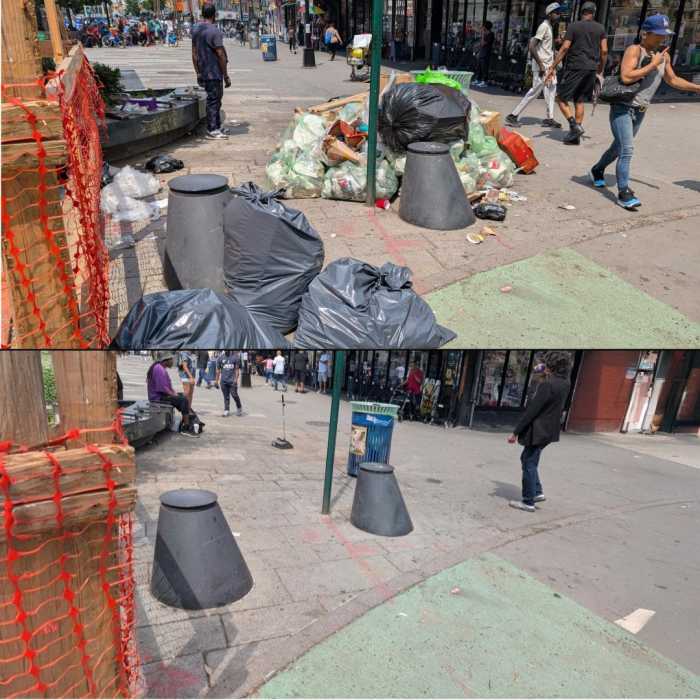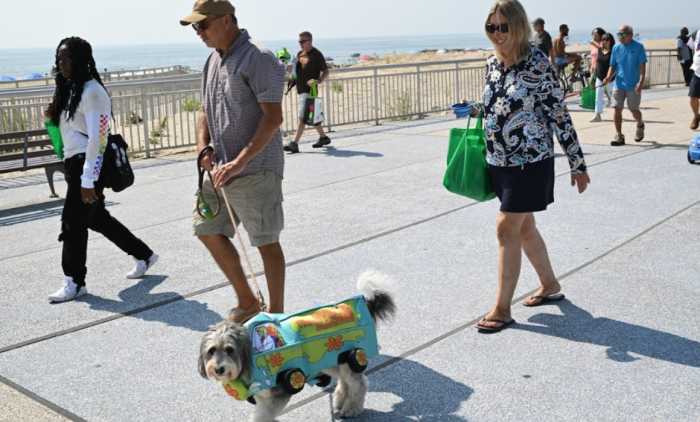By JERRY TALLMER
John Epperson gives Medea the Margaret Mitchell treatment
Michael Hunsaker, Jay Rogers and Nancy Opel in John Epperson’s “My Deah.”
On the day of the opening night of his play about a Jackson, Mississippi, ex-beauty queen named My Deah who murders her own two children to get back at her unfaithful ex-football- hero-slob husband, John Epperson was having lunch at Moustache, a tiny Middle Eastern restaurant on Bedford Street in Greenwich Village.
Just outside, some movie or other was getting ready to be shot. The entire block from Grove to Barrow was impassably blocked with trucks, trunks, power cables, and huge high-powered lights on stanchions.
Epperson, who has seen virtually every movie ever made, and — in the persona of Lypsinka — has brilliantly mimed dozens of Hollywood’s greatest leading ladies emoting their heads off without a sound passing through his own lips, was not amused at having to wade through all that gear on his way to eat and talk. But then, suddenly, as a fellow and a girl came laughing into Moustache, John Epperson sat up straight with excitement.
“That’s Aaron Eckhart!” he exclaimed. “You know, the guy who was in that Julia Roberts movie, ‘Erin Brockovich’?” Then Epperson’s face fell. “But he’s so much shorter than I thought,” he said.
An interviewer remarked that a lot of actors were shorter than one thought from the screen: Pacino, Hoffman, De Niro, et al. It’s the talent that counts — isn’t it? — not the height.
“Well, I’m talking about desire,” said Epperson, who in another and ironic breath revealed his sub-rosa yen for a gentleman elsewhere in the world of showbiz and journalism. As a matter of fact, stringy, gangly, redheaded playwright Epperson said he’d thought of playing the character My Deah himself in its present incarnation at the June Havoc Theatre on West 36th Street, “but where do you find a leading man tall enough for me? And now we know Aaron Eckhardt is not that man.”
The My Deah of the show — i.e., a Southern-fried Medea — is actually actress Nancy Opel, who also (but not simultaneously) plays My Deah’s fierce, faithful old housekeeper. Little V. Maxwell Caulfield is husband Gator Hedgepeth (i.e., Jason the jerk), Peter Brouwer is tyrannical Governor Bullard (i.e., Creon), and Lori Gardner is Bullard’s vacuous, sex-mad daughter Simplicity, the bait of Jason’s dire fate.
Where does one get such ideas, or the very idea of Medea / My Deah?
From “Gone With the Wind,” of course. From “Frankly, my dear, I don’t give a damn,” of course, with a touch of Southern dialect thrown in, as often throughout the pages of the Margaret Mitchell novel.
John Epperson knows about the South. He was born and bred there, in Hazlehurst, Mississippi. Salted throughout his play are lines, names, place-names, buried treasures, fragmented quotes from many of the novels and plays and films of our lifetime, beginning with Yoknapatawpha, the Mississippi county where most of the books of William Faulkner are rooted.
One short four-line exchange between two of My Deah’s girlfriends (Myrna Loy Seabrook and Brooksie Jones) incorporates references to Tobacco Road, Petticoat Junction, Raintree County, and Belle Rive, the lost homestead of “Streetcar’s” Blanche Dubois, but here Belle Riveis nuthouse to which Governor Bullard wants to dispatch My Deah.
There’s even, Epperson points out, “one reference nobody knows, to ‘Claudelle Inglish’ — not English — by Erskine Caldwell, both the book and the movie. It has a line in it my sister and I said all the time, growing up: ‘You think you’re somethin’, don’cha!’ ”
His sister is, today, Kay Wise — “that would be her third husband” — who lives in Jackson, Mississippi, “and whose 12-year-old daughter Sigrid I spoke with today because she’s rehearsing ‘The Nutcracker.’ I have another niece, Molly, by my sister’s first marriage, who’s a schoolteacher in Jackson.”
He also had another sister, who was killed in an automobile accident when John was 14. Her name was Sue.
“My family” — retired mail carrier John Epperson, Sr., housewife and saleswoman Joyce James Epperson — “sort of never recovered from that. Me? I bear the scars, but it’s not the kind of thing my parents, who grew up during the Depression, would talk about. Repression! Push it down, push it down!”
After a pause:
“If you note at the end of the play, My Deah dies in an auto accident. In every bit of research I’ve read” — and he read a lot — “she gets away. I just thought we should have closure in the modern, moral sense.”
He’s been nursing this play along for six years now. Wrote it first for “a little non-profit group of friends of mine who’d done an illegal production of my ‘Imitation of Imitation of Life’ ” — the 1959 Lana Turner remake, not the 1934 Claudette Colbert original.
It was a big success. I played Lana Turner. So then I wrote ‘My Deah,’ to give them something that wouldn’t be illegal — and they turned it down! I first wrote it as a role for myself, but then decided it should be done by a generic female.
“Then there was a reading of it with Betty Buckley at New York Theater Workshop, and they passed on it. Then I got kind of busy on other stuff, the Lypsinka show and doing ‘The Roaring Girle,’ a Jacobean play, at the Foundry. Then I did the stepmother in Rodgers & Hammerstein’s ‘Cinderella’ for New York City Opera.
“Then I had some time on my hands, and I read through the drama section of The New York Times every day, seeing what theater groups were doing what,
and I Googled up all those groups and sent each one three copies of this play, and the Abingdon Theatre Company and a children’s theater were the ones who liked it. So here we are.”
Did you really see every movie that’s buried in the text of the play?
“Yeah, I guess I did. Well, maybe not every second of ‘This Property Is Condemned,’ a really bad picture. When I first came to New York in 1978 there were revival houses all over town, the Thalia, the Regency, lots of others. I used to go every day. And then ‘The Big Chill’ came along — such a bore, what’s everybody talking about? — so I stopped going to movies for a while.”
He is, however, in a number of flicks, notably Todd Stephens’s recent “Another Gay Movie” and the 2004 “Kinsey” starring Liam Neeson and Laura Linney.
“It’s when [sex researcher] Kinsey goes to a gay bar in Chicago to ask a homosexual what it’s like. I’m the one he talks with. But it was shot in a bar under the subway tracks in Woodside, Queens. I spent the whole time calling Liam Neeson ‘Mary.’ ”
Liam Neeson is very tall, by the way — a very tall leading man. Maybe you and he could take over as Gator and My Deah, one of these days.
MY DEAH. By John Epperson. Directed by Mark Waldrop. An Abingdon Theatre Company presentation through November 12 (or longer) at the June Havoc Theatre, 312 West 36th Street, (212) 868-4444.





























